| 021 | 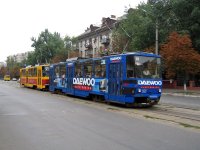 | Yaltinskaya Ulitsa in the neighborhood of Novaya Darnitsa. The tram line here connects Darnitsky Vokzal with Krasny Khutor and Poznyaki. Here a T6 trainset with 021 at the head is serving route 29, from Krasny Khutor towards Metro Lesnaya. The white brick house behind the trees is commonly referred to as Stalinka (Stalin-style).
[Stefan Mashkevich, 30.08.2003] |
  |
| 022 | 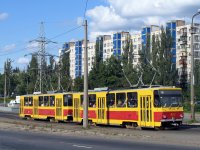 | Bratislavskaya Ulitsa. The train has just left the Ulitsa Andreya Malyshko stop and is proceeding towards Metro Chernigovskaya, on the way to its final stop at Metro Lesnaya.
[Stefan Mashkevich, 12.09.2006] |
  |
| 023 | 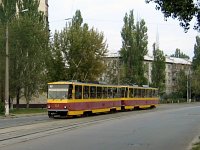 | Prazhskaya Ulitsa in Staraya Darnitsa. Train 022+023 on route 33, from DVRZ to Voskresenka, is approaching the intersection with Azerbaydzhanskaya Ulitsa. It is quite suprising nowadays to see a street totally devoid of traffic except for the tram.
[Kostj Kozlov, 17.09.2003] |
  |
| 024 | 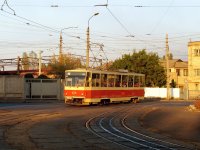 | Ulitsa Pavla Usenko enters an industrial zone in Darnitsa. Here the 024 on route 29, bound for Metro Lesnaya, turns from Usenko
onto Krasnogvardeyskaya (the photographer stands on the latter).
The turn in the other direction is towards Azerbaydzhanskaya Ulitsa.
[Stefan Mashkevich, 03.10.2005] |
    |
| 025 | 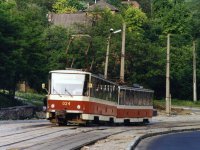 | Staronavodnitskaya Ulitsa in the neighborhood of Pechersk reminds one of how in the old times, bridges across the Dnieper were set up yearly in the place where the modern Paton bridge stands. (Staro- means 'old', and the verb describing setting up a bridge is navodit.)
Trams started running here in 1962, after a major realignment of the Podol-Pechersk routes. A major trans-Dnieper route 27, which connected Bessarabka in the downtown area with the outskirt of Voskresenka, existed until 1998, when this line was demolished in one of the first steps of the then-Mayor Omelchenko's "war on trams". Here the train is passing by the Redutny Pereulok stop, bound for Bessarabka on the aforementioned route 27.
[Aare Olander, 1990's] |
    |
| 026 | 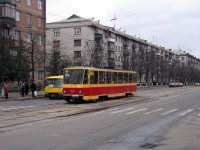 | Yaltinskaya Ulitsa again. A single car near the Ulitsa Sormovskaya stop is on route 8, bound for Poznyaki.
[Stefan Mashkevich, 20.11.2004] |
        |
| 027 | 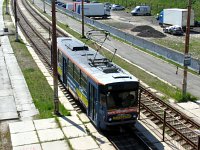 | In 2000, largely through the efforts of the above-mentioned Mayor Omelchenko, a second speed tram line in Kiev appeared, in the neighborhood of Troeschina. The only problem with it was that it was purely "local", lacking connections to any transportation hub.
As a result, it turned out to be quite unpopular. Service here was quite infrequent, and in January 2009, in view of the global economic crisis,
it was suspended altogether. Hence this picture is already historic.
The vantage point is a viaduct over one of the stations on the line.
[Kostj Kozlov, 05.05.2007] |
|
| 028 | 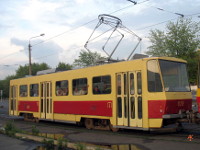 | In 2006, a shortage of tram parts began to be felt
in the Darnitsa Depot; all available resources had to be scrambled.
This is an example of such an approach: a T6 car 028 was equipped with
window panes from a T3, resulting in a rather eerie look.
The picture was taken at the end of Prospekt Gagarina, next to
the Darnitsa bus terminal, on route 28.
[Anton, 12.06.2007] |
|
| 029 | 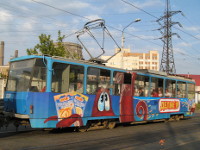 | The line on Krasnogvardeyskaya, running through an industrial zone, was laid out in the beginning of the 1990s, with the single, rush-hour only route 23 running there.
However, the autumn of 2004 saw passenger service on this line expand
vastly, with the suspension of all tram traffic on Prospekt Gagarina and the resulting realignment of the trans-Darnitsa tram routes.
Here a trailer 029 is following the lead car 048 on route—8, bound
for Metro Lesnaya.
[Anton, 05.09.2007] |
|
| 030 | 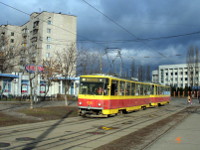 | Ulitsa Kibalchicha in the residential area of Voskrsenka. The train is serving route 35, from Troeschina towards Metro Lesnaya.
A Fora food supermarket is on the left.
[Anton, 20.01.2007] |
|
| 031 | 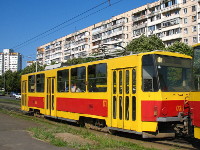 | Ulitsa Zakrevskogo in Troeschina.
The train 030+031 is on route 35, bound for Ulitsa Saburova.
[Anton, 27.07.2006] |
|
| 032 | 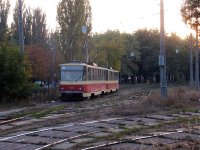 | The Bulvar Perova terminus (situated actually
on Ulitsa Suleimana Stalskogo). The abundance of tram tracks is
an evidence of its past importance; nowadays, however, a single route 22
ends here.
[Stefan Mashkevich, 03.10.2005] |
  |
| 033 | 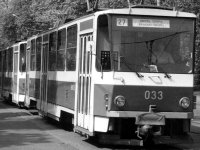 | Another shot of the old route 27, this time
on Ulitsa Kirova (nowadays Grushevskogo), likely near
Mariinsky Park. Both cars are in the manufacturer's livery.
[Kiev Electric Transportation Museum, 1990's] |
  |
| 034 | 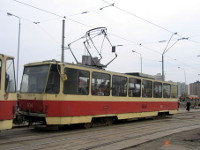 | The train is leaving the Metro Poznyaki terminus,
bound for Metro Lesnaya on route 8. In the background one can
see the viaduct over Prospekt Bazhana.
[Anton, 31.03.2006] |
  |
| 035 | 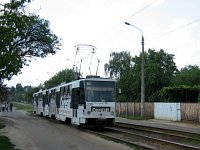 | Another T6+T6 train on route 29, this time
on Tashkentskaya Ulitsa in the area of Krasny Khutor.
Both cars are in the same advertisement livery.
[Kostj Kozlov, 19.07.2003] |
    |
| 036 | 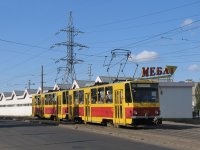 | Train 036+037 is turning from Miropolskaya Ulitsa
onto Komsomolskaya, on route 35.
The barracks in the background are buildings of the Yunost market,
the largest one in the neighborhood.
[Stefan Mashkevich, 12.09.2006] |
|
| 037 | 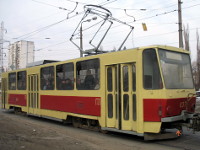 | Once again, Bratislavskaya Ulitsa,
next to the Andreya Malyshko stop. The trainset is on route 35,
the next stop being Metro Chernigovskaya.
[Anton, 14.03.2007] |
|
| 038 | 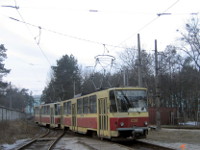 | A T6+T6 trainset is entering the DVRZ terminus of
route 33. This neighborhood is essentially a worker's residential
area adjacent to a big factory in the outskirts of Kiev.
[Anton, 02.01.2006] |
|
| 039 | 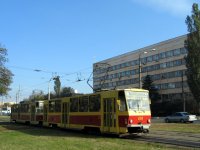 | Bulvar Verkhovnogo Soveta, mentioned on the previous page. This an historical picture by now: trams no longer run here, and the picture
was taken during the last days of tram service. This alignment existed
from 1992 (when the left turn from Prospekt Gagarina onto Krasnogvardeyskaya
Ulitsa, towards Metro Chernigovskaya, was liquidated, and trams had to
go in a somewhat roundabout way around a small park) until 2004,
when all tram service on Prospekt Gagarina was suspended and
the routes realigned via an industrial area near the Darnitsa Depot.
[Anton, 16.10.2004] |
  |
| 040 | 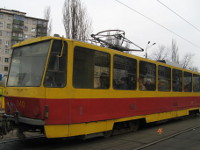 | The tram line linking Voskresenka and Troeschina
with the red line of the metro passes through Ulitsa Kurnatovskogo.
This is where the picture of the 041+040 train, on route 35, was made.
Behind the commercial kiosks there is a typical apartment block dating back to 1966.
[Anton, 08.02.2008] |
|